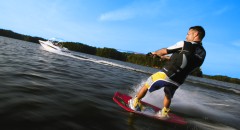By Shaun Murray
Download a printable version of this workout.
Wakeboarding is unique among action sports for the forces that we deal with while riding. We must constantly adjust to the pull of the rope and the push of the board. As a result, wakeboarding is a very core-centered sport, and you should always work to keep the area from the bottom of your rib cage to the tops of your knees strong. While nothing can completely mimic the pull and push forces of actually wakeboarding, I use these 10 workouts to stay in shape when I’m not on the water. I focused on making these workouts accessible to everyone, so only a jump rope, a pull-up bar, some steps, a rope or pole, and a little space are required. Pacing yourself is key, because you not only want to make it to the end of the workout, you also want to have the energy to complete the next day on your schedule. I try to work out four to five times a week with at least one day off for rest and recovery.
1. Jumping Rope
Start with 50 two-footed jumps at a leisurely pace. Next, perform 25 one-footed jumps on each foot. Go back to two-footed jumps, but this time accelerate your pace. Finish up with 10 double unders.
Wakeboarding benefits: Coordination, cardio and injury prevention
2. Pull-Ups
Form is key, so focus on extending fully at the bottom, getting at least your chin over the bar, and staying in control all the way down — don’t just drop. Alternate between a wide and a narrow grip. You might be able to do only three or fewer reps, but do your best to work up to at least 10. I do at least three past when I feel a burn.
Wakeboarding benefits: Improves grip strength, toughens soft hands, and strengthens your shoulders, arms, back and core
3. Frog Hops — Straight
Perform 10 straight-forward jumps from a full squat and focus on fully extending your legs and arms. Try to gently cradle your landings — imagine landing on a scale and trying to keep the weight from spiking to a high number.
Wakeboarding benefits: More explosive leg strength for more powerful takeoffs, improved strength, technique and range of motion on landings, and core strength for better balance
4. Two-Footed Step Jumps
On a set of stairs, jump up steps 1, 2, 3 and 4, turn and then jump down 4, 3, 2, 1. Repeat until it burns and then do one more set.
Wakeboarding benefits: More explosive leg strength for more powerful takeoffs, improved landing control and better coordination
5. Frog Hops — Angle
Perform 10 jumps at a 45-degree angle. Just as you did with straight frog hops, focus on full extension and soft landings.
Wakeboarding benefits: Increased dynamic range of motion, which contributes to more powerful takeoffs and controlled, injury-free landings
6. Hanging Leg-Ups
Hang from a bar with your arms fully extended and your feet together. While keeping your legs straight, lift them slowly over a one-second count. When your legs reach a 90-degree angle, hold for a count of “one Mississippi,” and then lower them slowly over a one-second count. Each rep should take approximately three seconds. Do a few reps past burn.
Wakeboarding benefits: Improved grip and stronger core
7. Pole or Rope Climb
The rope climb — or in my case, the pole climb — is one of the best upper body and grip workouts. Use both arms to pull, then hold strong with one arm while reaching as high as you can with the free arm. Make each reach count. At first, use your legs to rest, but don’t use them to help you get higher. Work up to eventually using no legs at all.
Wakeboarding benefits: Improved grip and stronger shoulders, arms, back and core
8. Single-Leg Box Jump
On a set of stairs, start with the first step and perform 10 jumps with your left leg and 10 jumps with your right leg. Move on to the second step and perform five jumps with your left leg and five jumps with your right leg. Take your time and focus on soft, controlled landings. Don’t move to the next rep until you are planted and in control.
Wakeboarding benefits: Increased power and control on takeoffs and landings as well as stronger legs and core
9. Standard Box Jump
Jumping up is important, but coming down is just as important, so really focus on cradling your landing. Don’t make your box jump super-high to prove a point. Make it a height at which you can stay in control. If it doesn’t feel good, stop and make the jump lower. Do three past the initial burn but be careful not to push it too far.
Wakeboarding benefits: Increased power and control on takeoffs and landings, stronger legs and core, and more pop off the wake
10. Chin-Ups
Full extension is a little harder but focus on maxing out your range going up and going down. To add a degree of difficulty, keep your legs straight and see how far out in front you can keep them while going up and down.
Wakeboarding benefits: Increased grip strength and stronger arms and core

